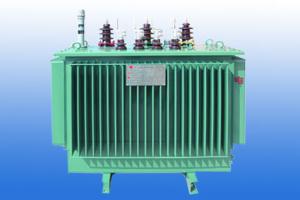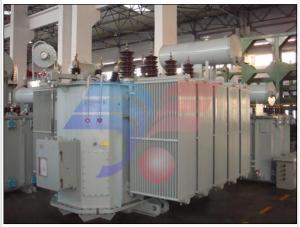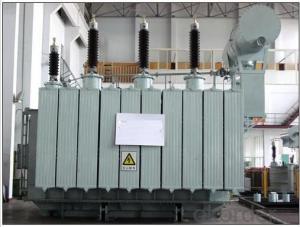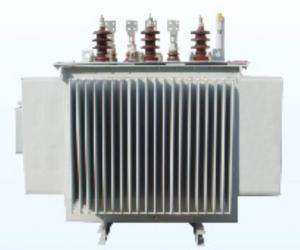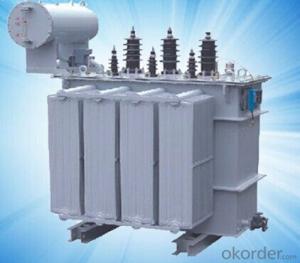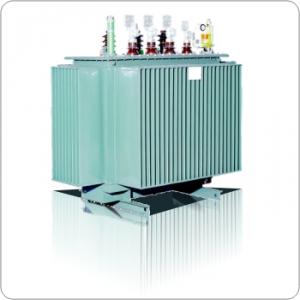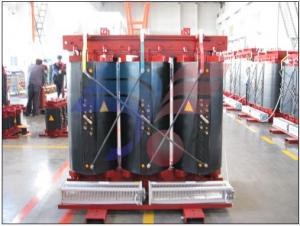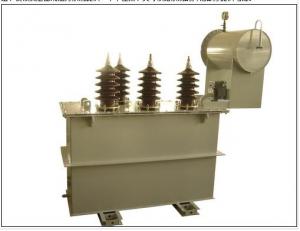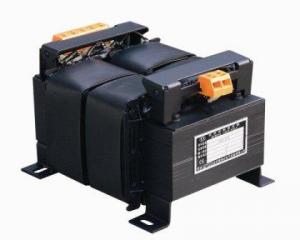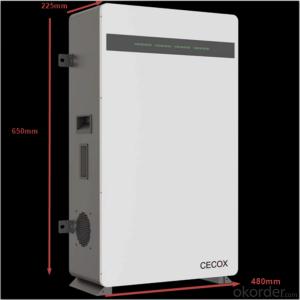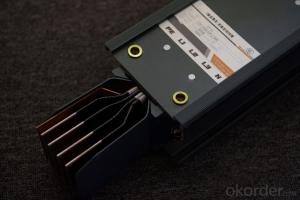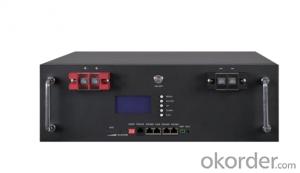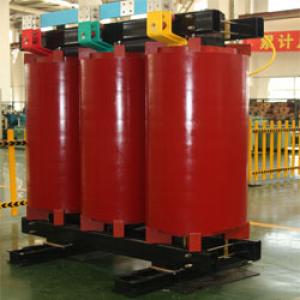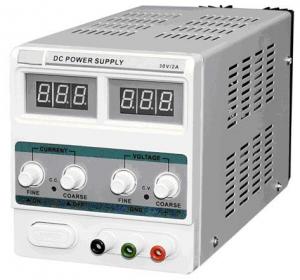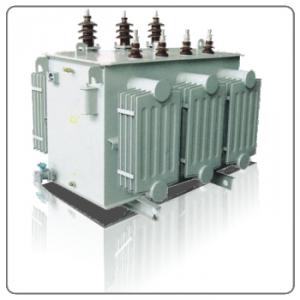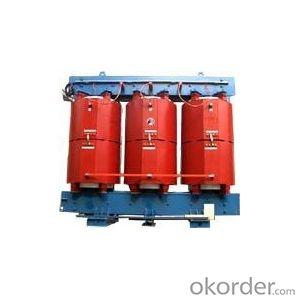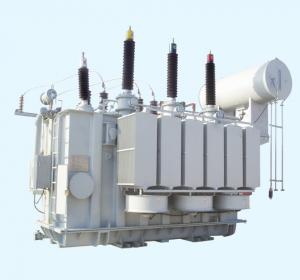Class 10KV S9-M series full-sealed transformer
- Loading Port:
- Shanghai
- Payment Terms:
- TT OR LC
- Min Order Qty:
- -
- Supply Capability:
- 1000sets set/month
OKorder Service Pledge
Quality Product, Order Online Tracking, Timely Delivery
OKorder Financial Service
Credit Rating, Credit Services, Credit Purchasing
You Might Also Like
| ted capacity (KVA) | Voltage | connection group tab | Loss | unload current(%) | resistant voltage | weight | Measure(MM) | Distance of Din rail | |||||||
| high-voltage(kv) | extend connection | low-voltage(kv) | unload | load | empty weight | oil weight | total weight | length(L) | width(W) | height(H) | cross(M)×length | ||||
| 20 | 6 | ±5% (±2×2.5%) | 0.4 | Yyn0 or Dyn11 | 105 | 480 | 3.0 | 4 | 135 | 75 | 280 | 1075 | 695 | 910 | 350×350 |
| 30 | 130 | 600 | 2.1 | 175 | 85 | 335 | 1105 | 700 | 950 | 400×450 | |||||
| 50 | 170 | 870 | 2.0 | 215 | 75 | 360 | 775 | 775 | 945 | 400×450 | |||||
| 63 | 200 | 1040 | 1.9 | 275 | 105 | 470 | 1170 | 720 | 1065 | 400×450 | |||||
| 80 | 250 | 1250 | 1.8 | 280 | 90 | 455 | 820 | 820 | 980 | 400×450 | |||||
| 100 | 290 | 1500 | 1.6 | 315 | 95 | 500 | 820 | 820 | 1005 | 400×450 | |||||
| 125 | 340 | 1800 | 1.5 | 365 | 105 | 580 | 850 | 850 | 1045 | 400×450 | |||||
| 160 | 400 | 2200 | 1.4 | 425 | 110 | 660 | 1135 | 1135 | 1075 | 550×550 | |||||
| 200 | 480 | 2600 | 1.3 | 500 | 130 | 775 | 1190 | 1190 | 1120 | 550×550 | |||||
| 250 | 560 | 3050 | 1.2 | 595 | 150 | 915 | 1215 | 1215 | 1140 | 550×550 | |||||
| 315 | 670 | 3650 | 1.1 | 700 | 170 | 1075 | 1285 | 1285 | 1200 | 660×660 | |||||
| 400 | 800 | 4300 | 1.0 | 865 | 195 | 1280 | 1305 | 1305 | 1285 | 660×660 | |||||
| 500 | 960 | 5150 | 1.0 | 985 | 220 | 1490 | 1455 | 1455 | 1275 | 660×660 | |||||
| 630 | 1200 | 6200 | 0.9 | 4.5 | 1140 | 250 | 1735 | 1555 | 1555 | 1285 | 660×660 | ||||
| 800 | 1400 | 7500 | 0.8 | 1400 | 290 | 2110 | 1660 | 1660 | 1375 | 820×820 | |||||
| 1000 | 1700 | 10300 | 0.7 | 1560 | 400 | 2475 | 1685 | 1685 | 1550 | 820×820 | |||||
| 1250 | 1950 | 12000 | 0.6 | 1915 | 465 | 2985 | 1805 | 1805 | 1505 | 820×820 | |||||
| 1600 | 2400 | 14500 | 0.6 | 2330 | 530 | 3745 | 1840 | 1840 | 1690 | 820×820 | |||||
- Q:I check the voltage between x1 and x2 I got 120v but between x1 and ground on primary I got 40v and between x2 and ground on Primary I have 50v, if I connect x2 to ground won't it short the transformer? Thank you
- What you see is normal, until the transformer is grounded the voltage floats. It is the same with the power for your house, the secondary of the transformer is normally grounded at the utility transformer, and at your ground rods, and to your water lines. X2 is the normal side grounded, although this has never made sense to me. You can imagine this, connecting one end of a flashlight battery to the frame of a car does nothing, you could then attach the other end of the battery to a light bulb, and the other bulb connection to the end of the battery or the frame, it only shorts if you connect the hot to the ground if you don't connect through a correctly rated load. Edit: Yes, ground it to the ground screw that the 208v ground wire is connected to, just to be clear, 208v connections H1 and H2 should not be grounded, and either x1 OR x2 needs be grounded, normally x2, grounding the transformer connection that is not connected to fuses.
- Q:My device has 50KW should be used with much transformer
- On the use of 50KVA transformer on the line, because your device will not appear at the same time the maximum power.
- Q:I broke a small transformer that I found inside of my DVD player, and I would like to have one (not for the DVD player, just separately) I would like the transformer to take in low voltage, such as a few AA or AAA batteries, and I want it to scale that up. Does anyone know where I can get one? If not are there any instructions on how to make an effective yet inexpensive one?Thanks in advance!
- A transformer cannot step up or step down DC power. (All batteries are DC). That is part of their nature. A basic transformer is nothing more than two (or more) inductor coils in close proximity, often with a steel core to help with the magnetic fields. All inductor coils are basically a coil of conducting wire, most often copper.
- Q:An AC generator, originally designed to provide a peak output voltage of ± 155 V at a frequency of 60 Hz, is required to provide a peak output of ± 340 V at 50 Hz. If the generator is connected to a transformer with 200 loops in its primary coil, how many loops should there be in the secondary coil in order to provide the required output?Using the formula Np/VpNs/Vs I get 439 coils, but this is too easy for a 6 mark question and doesn't include the change of frequency. I have no idea what to do and need some help :(
- Transformers cannot change the frequency of an electrical signalperiod. It requires more sophisticated electronics to do that. Perhaps your instructor is confused.
- Q:If a typical class 2 transformer is rated at 40 va.what is its true power rating(purely resistive load)and how is it calculated? Thx
- If the load is purely resistive then the power factor is 1. This is because the true power is equal to the apparent power. The reason the true power is not always the same as the apparent power is because the load may be either capacitive or inductive. This causes the phase of the current waveform to be either leading or lagging compared to the voltage waveform. Power is still the voltage times the current but since they are out of sync if you slice up the waveform into small segments and do the calculation for each slice and the average them all together the real power is less then the apparent power. The apparent power is the the product of the rms voltage and the rms current. The answer to your question is that the true power rating is the same as the apparent power rating. It is not calculated because by definition if the load is purely resistive the true power rating is the same as the apparent power rating. I hope this helps.
- Q:I want to know how much the current will increase. But the transformers i'm looking at VCT VT10000 - 10,000 Watts Heavy Duty Continuous Use 110V / 220V / 240V Step Up / Step Down Voltage Transformer or 15,000 Watt Step Up and Step Down Voltage TransformerI figure the whats is the total possible power and if you divide the power by the intial voltage you get the current and if you divide by the out put voltage you get the final current? but what if you input doesn't equal 15000 watts or whatever the power is?
- Bascally you are right. Watts is the maximum power, and dividing that by voltage provides amps. The transformer will pass what its load is consuming. If there is not enogh source eupply for the load, the source will burn out or blow its fuse/breaker.
- Q:I use a 1000 watt transformer for my tv, dvd player, cd player, game cube and nintendo (only 2 can be plugged in at a time or it is a fire hazard). The transformer is very strong and flips the circuit breaker if anything else in the house is plugged in and I try to plug that in. I'd rather not have to unplug everything to plug it in but I am worried I am wasting electricity if I keep it plugged in. So my question is does transformers use energy if they are plugged in and the appliances plugged into it aren't turned on? Also, do you think I can use a smaller transformer for those items listed above if it does use energy? The boxes that I buy them in don't say, they just say what watt they are.I've tried to look it up but I can't understand any of it so thank you in advance for helping me.
- NO But there's some exceptions Any appliance that turns on with a remote does not turn fully off (up to 20 Watts can be lost in standby mode) The modern PC has a logic level on / off switch which turns off only part of the Power Supply To the other PEDANTS of this world, I know I said NO as my first word to answer this question as soon as you increase the capacitance by allowing electricity to connect to the cable (of the hairdryer) extra electricity flows .but it's very small and it's not in phase (90 deg) so compared to the hair dryer in operation it's absolutely negligible
- Q:How do step up transformers obey the law of conservation of energy?
- An ideal transformer neither generates nor consumes energy, so the power entering it will equal the power leaving it. Power can be computed by multiplying the RMS voltage by the RMS current. So, if an ideal transformer has an input voltage of (say) 100 V and an output voltage of 200 V, the current coming out will be exactly half the current going in. A real transformer is not ideal but dissipates power owing to the finite resistance of its windings and other effects, so if a real transformer steps up voltage from 100 V to 200 V, its output current will be less than half its input current.
- Q:A step-up transformer is connected to a generator that is delivering 131 V and 96 A. The ratio of the turns on the secondary to the turns on the primary is 859 to 1. What voltage is across the secondary? An-swer in units of kV.What current flows in the secondary? Answer in units of mA.
- Vp Voltage Primary Vs Voltage Secondary Np Number of Turns Primary etc The values you have given are primary, why? Because its Generator Transformer (GCSE stuff) Equation : Vp/Vs Np/Ns 131 / Vs 1 / 859 Vs 112529 V (large cause its a step UP transformer) 2). This equation is similar just slight different order: Vp / Vs Is / Ip (Hence you can rearrange this for power but not needed here) 131 / 112529 Is / 96 Is 0.11 A (2dp) Yet again you'd expect it to be small, because your transforming your voltage upwards to reduce your current (which of course creates less heat so less heat energy lost etc)
- Q:Want to use in the air compressor, I do not know it?
- Can not. Because the main role of transformer oil insulation is not lubrication. Its water absorption is strong.
1. Manufacturer Overview |
|
|---|---|
| Location | |
| Year Established | |
| Annual Output Value | |
| Main Markets | |
| Company Certifications | |
2. Manufacturer Certificates |
|
|---|---|
| a) Certification Name | |
| Range | |
| Reference | |
| Validity Period | |
3. Manufacturer Capability |
|
|---|---|
| a)Trade Capacity | |
| Nearest Port | |
| Export Percentage | |
| No.of Employees in Trade Department | |
| Language Spoken: | |
| b)Factory Information | |
| Factory Size: | |
| No. of Production Lines | |
| Contract Manufacturing | |
| Product Price Range | |
Send your message to us
Class 10KV S9-M series full-sealed transformer
- Loading Port:
- Shanghai
- Payment Terms:
- TT OR LC
- Min Order Qty:
- -
- Supply Capability:
- 1000sets set/month
OKorder Service Pledge
Quality Product, Order Online Tracking, Timely Delivery
OKorder Financial Service
Credit Rating, Credit Services, Credit Purchasing
Similar products
New products
Hot products
